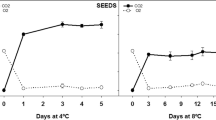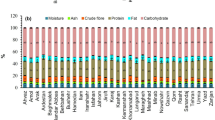Abstract
Cowpea is among the most grain legumes consumed in Algeria. The Algerian Saharan is a hostile environment characterized by high temperatures, scarcity of water and salinity of water and soil. In these regions, the farmers have for generations cultivated landraces cowpeas which are probably adapted to these particular environments and which may have particular nutritional and functional characteristics. These cowpeas deserve to be known and exploited in breeding and improvement programs. This study aims to determine the nutritional value and functional properties of Saharan cowpea through their chemical composition and the analysis of biochemical variability between accessions taking into consideration the environments of origin. Eighteen cowpea landraces were harvested in an arid region of southern Algeria (Hoggar, Tamanrasset). The seeds composition was evaluated by the determination of certain chemical characteristics such as moisture ash, crude protein, fat, total carbohydrates, and energy value. The antioxidant activity was also evaluated which includes total non-enzymatic antioxidant capacity (CANET) and lipid peroxidation, which were determined by conventional methods. The results showed variability among the accessions studied (p ≥ 0.05), and that all the landraces had high crude protein and total carbohydrates. The total non-enzymatic antioxidant capacity (CANET) recorded is low, as well as lipid peroxidation. The moisture content, ash content and fat content were also low in these saharan cowpea accessions. The Functional properties of the flour were also evaluated. The water absorption capacity (WAC) varies with an average of 1.17 g/gMS, the oil absorption capacity (OAC) with an average of 0.4 g/gMs, and the swelling index (SI) with an average of 2.63. The accessions NEA7 and NEA13 are the richest in protein and they have the highest nutritional value. We report here for the first time that cowpea seeds grown in the Hoggar region have high biochemical variability and highly acceptable functional characteristics; however, they could be a good source of nutrients.






Similar content being viewed by others
Data availability
The datasets generated and analyzed during the current study are available from the corresponding author on reasonable request.
References
N. P. Singh, Pratap A , in Biofortification of Food Crops, ed.By U. Singh , C. S. Praharaj , S. S. Singh, N. P. Singh ( Springer , New Delhi, 2016) , p.50
B.Vanlauwe , M. Hungria, F. Kanampiu, K.E. Giller, (2019). https://doi.org/10.1016/j.agee.2019.106583
M. B. Magrini, M. Anton, C. Cholez , G. Corre-Hellou, G. Duc, M.H. Jeuffroy M.H, J.M.Meynard, E.Pelzer, A.S.Voisin, S. Walrand. (2016). https://doi.org/10.1016/j.ecolecon.2016.03.024
R. Paliwal, M. Abberton, B.Faloye, O. Olaniyi. (2020). https://doi.org/10.1016/j.pbi.2020.05.002
B.B. Singh, O.L. Chambliss, A.B. Sharm, in Advances in cowpea research, ed.By B.B. Singh ,D.R.Mohanraj , E.Dashiellk, L.E.N. Jackai (IITA-JIRCA Ibadan, Nigeria, 1997), p. 49
A. Ashogbon, E. Akintayo, Inter Food Rese. Journal. 20(6), 3093 (2013)
L. Ogunkanmi, O. Ogundipe, N.N.G.C. Fatokun, J. Food Agri. Environ. 6(3–4), 8 (2008)
E. Sebetha , A.Modi, L.Owoeye, (2015). https://doi.org/10.5539/jas.v7n1p224
I. Stancheva, M.Geneva, M.Hristozkova; M.Sichanova, R. Donkova, G.Petkova, E. Djonova ( 2017) https://doi.org/10.1080/00103624.2017.1358740
S.C. Achinewhu, G.N. Akah, (2003).https://doi.org/10.1023/B:QUAL.0000040364.74521.d8.
F.C.D. Lopes, R.L.F. Gomes, F.R. Freire Filho, Sci. Agricola 60(2), 315 (2003)
W.M. Sharawy, Z.EL-Fiky , Arab. J. Boitech 6, 67–68 (2003)
C. Bennetau-Pelissero (2019). https://doi.org/10.1007/978-3-319-54528-8_3-1
E. Lazaridi, G. Ntatsi, D. Savvas, P.J. Bebeli, (2017). https://doi.org/10.1007/s10722-016-0452-6
M. Carvalho, T. Lino-Neto, E. Rosa, V. Carnide, J. Sci. Food Agric 97(13), 4273 (2017)
M.P.Timko, B.Singh, in Genomics of tropical crop plants,ed.P.H Moor , R.Ming (Springer ,New York,2008), p. 227
M. Carvalho, I. Castro, J. Moutinho-Pereira, C. Correia, M. Egea-Cortines, M. Matos, E. Rosa, V. Carnide, T. LIno-Neto (2019). https://doi.org/10.1016/j.jplph.2019.153001
K.A.Taiwo. (1998) https://doi.org/10.1016/S0166-4972 (98)00015–7
S.K. Diallo, D. Soro, K. Koné, N. Assidjo, K. Yao, D. Gnakri, Intern. J. Innovation. Sci. Rese. 18(2), 4342015 (2015)
H. Karimi-Maleh, F. Karimi, Y. Orooji, G.Mansouri , A. Razmjou, A.Aygun, F. Sen(2020), Scienti Reports, 10(11699 ),2020
M. Harbi Çalımlı ,Ö.Demirbaş, A. Aygün, M. Hakkı Alma, M. Salih Nas, A. Khan, A. M. Asiri, F. Şen (2019) https://doi.org/10.1007/s12668-019-00633-z.(2019)
Ö. Demirbaş, M. Harbi Çalımlı , B. Demirkan. M. Hakkı Alma, M. Salih Nas, A. Khan, Abdullah M. Asiri, F. Şen (2019) https://doi.org/10.1007/s12668-019-00628-w
Ö. Demirbaş, M. Harbi Çalımlı , B. Demirkan. M. Hakkı Alma, M. Salih Nas, A. Khan, Abdullah M. Asiri, F. Şen (2019) https://doi.org/10.1007/s12668-019-00635-x.
C.A. Koko, M. Diomande, B.K. Kouame, E.S.S. Yapo, J.N.D. Kouassi, Intern. J. Innova. Appli. Stud 17(2), 496 (2016)
A.Olusola, J. Chukwu (2020) https://doi.org/10.33945/SAMI/AJCA.2020.1.2
W. Prinyawiwatkul, K.H. Mcwatters, L.R. Beuchat, R.D. Phillips, M.A. Uebersak, Critic. Revie. Food Sci. Nutri 36(5), 413–436 (1996)
T.Haque, M.Tabassum, M. Jamilur Rahman, M.Siddique, M. Mostafa, M.Abdul Khalaque, Z.Abedine, H. Hamidi (2020). https://doi.org/10.33945/SAMI/AJCA.2020.2.7
N.Echikh, Organisation du pool génique de formes sauvages et cultivées d'une légumineuses alimentaire Vigna unguiculata (L) Walp. PhD Thesis, Faculté Universitaire des sciences Agronomiques de Gembloux: Belgium, (2000)
N.Gahlmi, PhD Thesis, Etude de la diversité génétique de quelques écotypes locaux de vigna unguiculata (L.) Walp. cultivés en Algérie .École Nationale Supérieure Agronomique : Alger, ( 2011)
N.Ghalmi , M. Malice, J.M. Jacquemin,S.M. Ounane, L.Mekliche, J.P. Baudoin. (2010). https://doi.org/10.1007/s10722-009-9476-5.
AOAC. Official method of analysis .Association of Official Analytical Chemist, 5th, Arlington, USA (2005).
FAO. Food energy , methods of analysis and conversion factors, Food and Agriculture Organization of the United Nations, Rome.(2003).
W. Maclean, J. Harnly, J.Chen, S. Chevassus-Agnes, G. Gilani, G. Livesey, P. Food and agriculture organization of the united nations technical workshop report. 77, 8 (2003)
P. Rieto, M. Pineda, M. Aguilar, Analy. Biochem 269(2), 337 (1999)
I. Cakmak, W. J. Horst. (1991). https://doi.org/10.1016/j.jplph.2019.153001
J. Abu, K. Muller, K. GyebiDuodu, A. Minnar. (2005). https://doi.org/10.1016/j.foodchem.2004.09.010
C.M.F. Mbofung, Y.N. Njintang, K.W. Waldron. (2002). https://doi.org/10.1016/S0260-8774(01)00196-0
E.N. Herken, I. Senol, M.D. Öner, N. Bilgicil, S. Güzel. (2007). https://doi.org/10.1016/j.jfoodeng.2005.10.005
R.A. Ghavidel, J. Prakash. (2000). https://doi.org/10.1016/j.lwt.2006.08.002
F. Appiah, J. Asibuo, P. Kumah, African J. Food Sci 5(2), 100 (2011)
A. Yusuf, H. Ayedun, L. Sanni, Food Chem. 111(2), 277 (2008). https://doi.org/10.1016/j.foodchem.2007.12.014
M. Boateng, J. Addo, H. Okyere, J. Berchie, A. Tetteh, Afr J. Food Sci Technol. 4(4), 64 (2013)
A. Mazahib, M. Nuha, I. Salawa, E. Babiker, Inter Food Rese. J. 20(3), 1165 (2013)
D.P. Kachare, J.K. Chavan, S.S. Kadam, Plant Foods. Human Nutri. 38(2), 155 (1988)
O. Boukar, F. Massawe, S. Muranaka, F. Jorge, B. Maziya-Dixon, B. Singh, C. Fatokun, Christian Plant Genetic Res. 4(9), 515–522 (2011)
T.S. Naiker, A. Gerrano, J. Mellem. (2019). https://doi.org/10.1007/s13197-019-03649-1
A. Balla, M. Baragé, Tropicultura 24(1), 39 (2006)
D.K. Séraphin, K.K. Youssouf, S. Doudjo, A.N.B. Emmanuel, Y.K. Benjamin, G. Dago, Europ. Scient. J. ESJ. 11(27), 288 (2015)
K.N.D. Jacob, K. Ayolié, A.C. Koko, M.A.S. Boyé, S.J. Gogbeu, T.D. Charlotte, T. Scholars J. Agricul. Veterin. Sci 3(4), 292 (2016)
S. Rahali-osmane, K. Boulahia, R. Djebbar, O. Abrous-Belbachir, Analele Univers. Oradea. Fascicu. Biolog. 1, 7 (2020)
P. Siddhuraju, K. Becker, Food Chem. 1(101), 10–19 (2007)
M.V. Avanza, M.G. Chaves, B.A. Acevedo, M.C. Añón. (2012). https://doi.org/10.1016/j.lwt.2012.04.015
I.O. Akinyele, A.O. Onigbinde, M.A. Hussain, A. Omololu, 51(6), 1483-1485 (1969)
A. IqbaL, A.I. Khalil, N. Ateeq, M.S. Khan, Food Chem. 97(2), 331 (2006)
M. Rivas-Vega, E. Goytortúa-Bores, J. Ezquerra-Brauer, M. Salazar-García, L. Cruz-Suárez, H. Nolasco, R. Civera-Cerecedo. (2006). https://doi.org/10.1016/j.foodchem.2005.03.021
J. Amarteifio, O. Tibe, R. Njogu, The mineral composition of Bambara groundnut (Vigna subterranea (L) Verdc) grown in Southern Africa. Afric. J. Biotechnol. 5(23), 2408 (2006)
S. Okonkwo, M. Opara, J. Rese, Appli. Sci 5(6), 394 (2010)
B. Anhwange, G. Atoo, J. Pure, ApplI. Sci. 2(1), 11 (2015)
M.S. Alidu, I.K. Asante, H.K. Mensah. (2020). https://doi.org/10.1016/j.heliyon.2020.e03406
J.O. Anyango, H.L. De Kock, J.R.N. Taylor. (2011). https://doi.org/10.1016/j.lwt.2011.07.010
M. Aremu, O. Olaofe, E. Akintayo, Bull. Pure Appli. Sci. 24(1–2), 2005 (2005)
M. Aremu, O. Olaofe, E. Akintayo, J. Appli Sci. 6(9), 1900 (2006)
R. Hoover, F. Sosulski, Canadian J. Physiol. Pharmaco. 69(1), 79 (1991)
Z. Ofuya, V. Akhidue, J. Applied Sc Environ. Managem. 9(3), 99 (2005)
D. Del Rio, A.J. Stewart, N.A. Pellegrini. (2005). https://doi.org/10.1016/j.numecd.2005.05.003
E.A. Bacelar, D.L. Santos, J.M. Moutinho-pereira, B.C. Gonçalves, H.F. Ferreira, C.M. Correia. (2006). https://doi.org/10.1016/j.plantsci.2005.10.014
N.A. Anjum, P. Sharma, S.S. Gill, M. Hasanuzzaman, E.A. Khan, K. Kachhap, A.A. Mohamed, P. Thangavel, G.D. Devi, P. Vasudhevan, Environ sci. pollu. Resear. 23(19), 19002 (2016)
O. Akinjayeju, K.T. Bisiriyu, Int. J. Food Sci. Technol 39(4), 355 (2004)
O.C. Adebooye, V. Singh, Innova. (2008). https://doi.org/10.1016/j.ifset.2007.06.003
C. Hutton, A.M. Campbell, J.P. Cherry. Am. Chem. Soc. ACS. 177 (1981)
M.S. Butt, B. Rizwana, Pakist J. Nutrit 9(4), 373 (2010)
R.M. Sandhya, K. Bhattacharya, J. Textu Stud. 20(2), 127 (1989)
K. Adebowale, O. Lawal, Food Rese. Internat. 37(4), 355 (2004)
P.O. Aremo, O. Olaofe, J. Food Technol 5(2), 109 (2007)
Acknowledgements
The authors acknowledge their funding agency in the public: The Directorate-General (La DGRSDT) for their financial support that they gave us during the whole realization period of this research. Also, our acknowledgments are to the members of the research group 02 of the laboratory of Integrated Improvement of Vegetable Productions ( AIPV-CP2711100) (El Harrach, Algiers), to Division of Agriculture and Biotechnology, National Research Center for Biotechnology (CRBT, Constantine, Algeria) and to Laboratory of Genetic, Biochemistry and Plant Biotechnology of University des Frères Mentouri Constantine 01, Department of Applied Biology, Faculty of Life Sciences (Constantine, Algeria) for providing us the technical assistance
Author information
Authors and Affiliations
Corresponding author
Ethics declarations
Conflict of interest
The authors declare that they have no conflicts of interest.
Additional information
Publisher's Note
Springer Nature remains neutral with regard to jurisdictional claims in published maps and institutional affiliations.
Rights and permissions
About this article
Cite this article
Aida, B., Sihem, T., Ines, B. et al. Biochemical variability and functional properties of cowpea landraces grown in Hoggar: the Algerian arid region. Food Measure 15, 3509–3522 (2021). https://doi.org/10.1007/s11694-021-00919-5
Received:
Accepted:
Published:
Issue Date:
DOI: https://doi.org/10.1007/s11694-021-00919-5




